Brown rot of stone fruits
The fungi that cause brown rot of stone fruits in Victoria are:
- Monilinia fructicola
- Monilinia laxa.
A third species of Monilinia, M. fructigena, affects pome and stone fruit in Europe and Asia, but has not been recorded in Australia.
Symptoms of brown rot
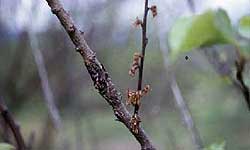
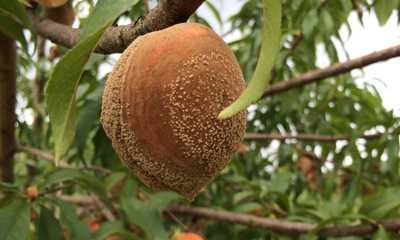
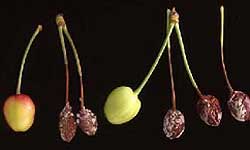
The following symptoms can indicate brown rot:
- blossom blight – a faint discolouration of the affected flower part. The fungus grows rapidly, and the entire floral structure is soon brown and shrivelled. This produces masses of spores. A canker (dead and discoloured area) may develop at the base of the flower.
- twig blight – this might follow flower infection if weather conditions are favourable for the fungus beyond the blossoming period. Small cankers at the base of dead flowers might extend until they girdle the twig, which will wilt and die (Figure 1).
- cankers might continue to extend towards a larger branch and can affect two-year-old and three-year-old wood. Gumming from cankers occurs.
- leaf shot-hole – young leaves become infected and a shot-hole symptom develops.
- quiescent infection – on green fruit, M. fructicola sometimes forms visible lesions that remain dormant until the fruit approaches maturity. Quiescent infections might be invisible or appear as small necrotic or brown-red lesions or haloes on the fruit surface. These lesions can become active and cause rotting of the fruit before or after harvest.
- brown rot of fruit – infection of the fruit usually occurs as the fruit approaches full ripeness. A rapidly spreading firm brown rot develops and the fungus produces masses of fawn-coloured spores often in concentric zones. Figure 2 shows these symptoms on peach. Infected fruit shrivel to a 'mummy'. If this remains in the tree it continues to produce spores (Figure 3 and 4). Brown rotted fruit in cold storage appear black and there may be no signs of sporulation.
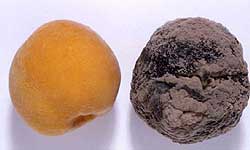
Economic importance
Brown rot can cause serious losses to stone fruit, especially in seasons with very wet weather during flowering or immediately pre-harvest.
Losses are mainly associated with blossom blight (which reduces fruit set and potential yield), and brown rot on maturing fruit close to harvest. Significant losses can also occur to fruit after harvest (Figure 5).
The disease is widespread throughout Victoria. In the past, major losses occurred throughout the extensive stone fruit production areas in eastern Australia, but such losses have been generally rare in recent years. This is largely due to improved management practices and more effective fungicides.
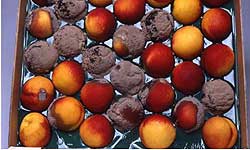
Life cycle
The disease-causing fungi are carried over from season to season on:
- mummified fruits
- peduncles
- cankers
- infected wood left on the tree.
Fruit and wood that fall and remain on the ground are also significant sources of infection. Blossom blight occurs to a greater or lesser extent in most years, and infected blossoms continue to produce spores up to and throughout the harvest period.
Injuries caused by insect pests, hail or fruit-splitting allow the establishment of infections and subsequent formation of spores.
Fruits that fall to the ground in the pre-harvest period and during harvest are readily infected with brown rot and are significant in starting of severe outbreaks.
Control measures
The following strategies can help control brown rot:
- Orchard sanitation – in winter remove all fruit mummies and wood showing cankers from the tree and ground. To prevent the spread of spores, ideally burn or deep bury the removed material, and certainly do not compost it near orchards.
- For the control of blossom blight, apply a suitable fungicide at bud-swell. Apply further sprays registered for the control of brown rot at early (20 per cent to 30 per cent) bloom and early petal-fall stages. During prolonged blossoming, particularly in showery weather, you'll need several sprays to give enough protection against infection.
- To prevent infection of the ripening fruit, spray with a suitable fungicide a month before harvest. Repeat the spray a fortnight later. Extra sprays might be needed if there are frequent rains in the month before harvest.
- To prevent developing fungicide-resistant strains of the disease-causing fungi, don't use a complete spray program of any one particular fungicide. Refer to Fungicide Resistance Management Strategies (FRMS) for more information.
- Control insect pests (especially Carpophilus beetles) that injure the fruit and that can also spread the disease-causing fungi.
- Apply post-harvest treatments for brown rot control as soon as possible after harvest.
Also, conditions favourable for brown rot can be minimised by:
- avoiding irrigation from above
- pruning interior branches to give the tree an open vase shape. This will increase air circulation for quicker drying of fruit and blossoms after rain and dew. It will also allow for the better penetration of fungicides and insecticides.
Photo credits
Figure 2 – Rebecca A. Melanson, Mississippi State University Extension, Bugwood.org
Reporting an unusual plant insect pest or disease
Report any unusual plant pest or disease immediately using our online reporting form or by calling the Exotic Plant Pest Hotline on 1800 084 881. Early reporting increases the chance of effective control and eradication.
Please take multiple good quality photos of the pests or damage to include in your report where possible, as this is essential for rapid pest and disease diagnosis and response.
Your report will be responded to by an experienced staff member, who may seek more information about the detection and explain next steps.
Report online